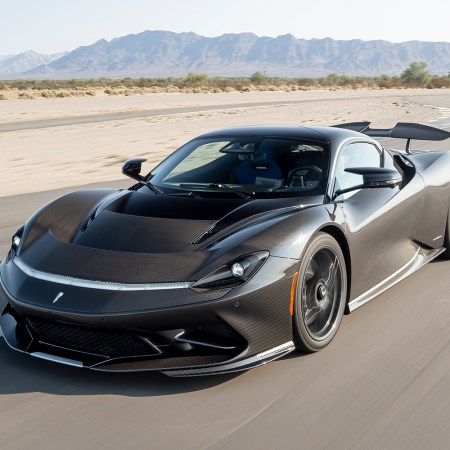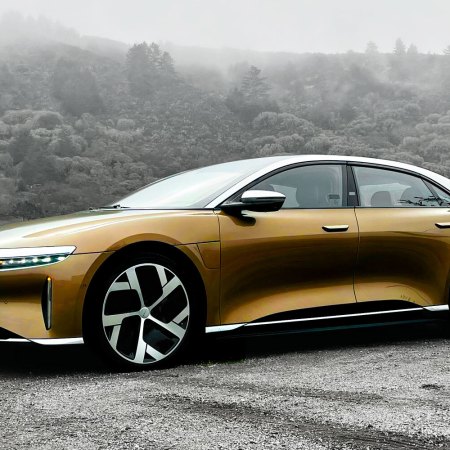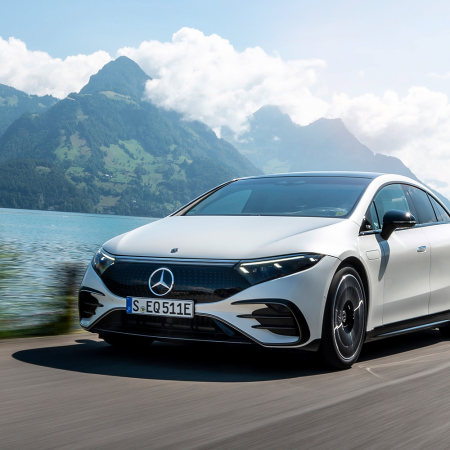There’s something about sitting behind the wheel of the Maserati GranTurismo Folgore that makes me want to do my best impression of Doc Brown in Back to the Future. “Gas? Where we’re going, we don’t need gas.” The new Italian two-door grand tourer is stunningly sculpted proof that electric power and technology can create a dynamic driving experience.
Of course, the future hasn’t entirely arrived. After all, we were promised jetpacks and cars that could take to the sky. Still, this new electric Maserati is an impressive waypoint and will absolutely fly…with its four wheels still on the ground.
By fly, I mean punch it and the Folgore can hit 60 mph in 2.6 seconds and reach a top speed of 202 mph. That’s probably faster than mere mortals need to travel, but faster still is the 17,600 rpm the electric motors are spinning, a speed my ICE-trained automotive brain can barely comprehend.
In between testing its internal-combustion-powered siblings, the Modena and Trofeo, on a press drive in Italy, Maserati handed me the keys — well a key fob — to an early production version of the Folgore to pilot over some country roads north of Rome. But that was enough for me to shout, “Great Scott!”

Maserati’s Electric Prowess
Instead of the V6 available in the two gas-powered GranTurismo models, here we’ve got three 300 kW radial electric motors. One sends power to the front wheels and one each drives the duo in the back. All three are all managed by silicon carbide inverters developed for Formula E, where Maserati has been competing for nearly a decade. On paper, the three motors are capable of 1,183 hp, but as they are tethered to a 92.5 kWh (84 kWh usable) battery that can’t give them quite enough juice, they are restricted to an output of 749 hp and 996 lb-ft of torque.
Review: Ripping Around Italy in the Resurrected Maserati GranTurismo
Two gas-powered models, the Modena and Trofeo, offer a classic fusion of luxury, speed and Italian panacheThat’s not too shabby, but what truly sets the Folgore apart from other performance EVs is how Maserati has solved the issue of battery mass. Electric cells are heavy and the Folgore weighs in at 4,982 pounds; that’s roughly 1,000 more than its gas-burning siblings. Most EVs deploy their batteries in what’s known as a “skateboard” layout, low and flat beneath the floor. But the Maserati engineers created a T-shape configuration for the Folgore that runs down the center of the car, where you’d find the transmission in an ICE vehicle. The design allows the driver to sit lower than in most EVs. In fact, the seating position is exactly the same as in the combustion-engine models.
Beyond the sports car sight lines, moving the mass to the center also reduces body roll and creates more stability when shifting directions, so the Folgore is lighter and more acrobatic as it dances through the corners.

Fear Factor
Ripping up some country roads north of Rome, you’d have thought I was in St. Peter’s, as I found myself repeatedly wincing, “Dear God!”
Not only is the Folgore stupefyingly fast, throwing down mondo power instantly with the slightest feathering of the throttle, but unlike most electric cars it’s easily managed in the zig-zags and hairpins with minimal roll and a metric ton of precision, which is to say it drives more like you’d expect a Maserati and less like a homogenous EV. As wonderfully clever as the solution is, they haven’t managed to hide all that extra girth. The Folgore is not quite as light on its rims as the Trofeo and Modena, but it feels quite close.
The version I tested was an early-build production model and Maserati is still in the process of tweaking things. To bring that point home, the cupholders were unusable. Instead of a cappuccino or a bottle of San Pellegrino, they were filled with a pair of battery kill switches. So I was only allowed to tackle a scant 50-kilometer route, but that was enough to get the gist of the Folgore’s potential.

Where We’re Going We Will Need Modes
Like every car nowadays, the Folgore has multiple driving modes, which not only control power output but also how it’s sent to the wheels (i.e., traction control and torque vectoring).
The Max Range setting keeps the power down and helps you go farther, which is important because, when it goes on sale later this year, Maserati is estimated to have an EPA-rated range of a little under 250 miles. When you run out of juice, a DC fast charger will take the battery from 20% to 80% in about 18 minutes. The GT setting gives the user only 80% of the battery and motors’ potential power, plenty for lazy cruising. Sport mode unleashes 100% of the power and unbuttons the traction control.
For the truly brave, Corsa disengages the traction control completely, so you can go fully ballistic. But it doesn’t take much for the absurdity of 996 lb-ft of torque to send the Folgore a little sideways. Push the pedal all the way to the floor on a public road and it would be easy to end up in a ditch, an Italian jail or trying to hide your face while shopping for new pants.

No Electric Homogeneity Here
The Folgore’s regenerative braking system, which grabs back juice at a max rate of 400 kW, features four levels of intensity ranging from coasting to near-one-pedal driving. Full one-pedal driving is a popular feature on many EVs, but Maserati believes its customers would prefer to maintain a higher level of driver input, and I would absolutely concur.
The Folgore is nearly identical to its ICE compatriots, the Modena and the Trofeo. But in the electric version, customers have the option of seating surfaces made from recycled fishing nets recovered from the ocean. Unlike many EVs, there is no “frunk,” but the actual trunk still offers enough storage for a good bit of luggage or a couple sets of golf clubs.
Inside the cabin, Maserati has given the Folgore a faux engine sound — and I’m just not that into it. The noise gets louder and, in my opinion, uglier as you start attacking the tarmac. Currently, there is no way to disable the simulated engine grumble, but the Folgore hasn’t hit the production line and Maserati is still making tweaks. Of course, EVs have to emit some sounds externally so pedestrians can hear them coming. But that’s not a requirement on the inside. So maybe they can add the sound of silence for those who prefer the quiet.
The Future Is (Almost) Here
The automotive future is electric. Full stop. When that future will be fully realized is an open question. But for now, Maserati has taken a helluva leap and successfully electrified its iconic, brand-defining grand tourer. That’s a pretty solid indication that at least part of our future is already here.
Official pricing for the Folgore is not yet available but it should start a tick or two higher than the $205,000 gas-powered GranTurismo Trofeo. Maserati will begin taking orders for the Folgore later this year and delivering in early 2024.
This article was featured in the InsideHook newsletter. Sign up now.






















